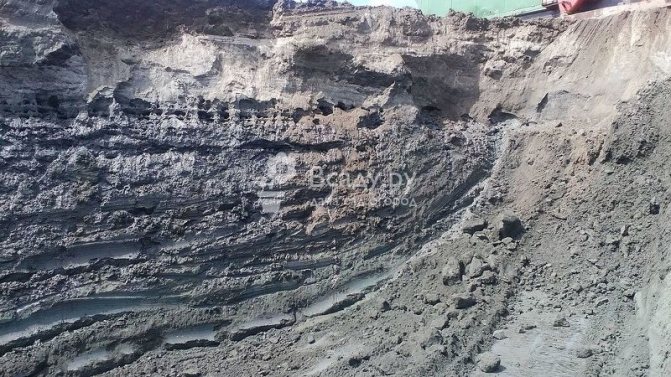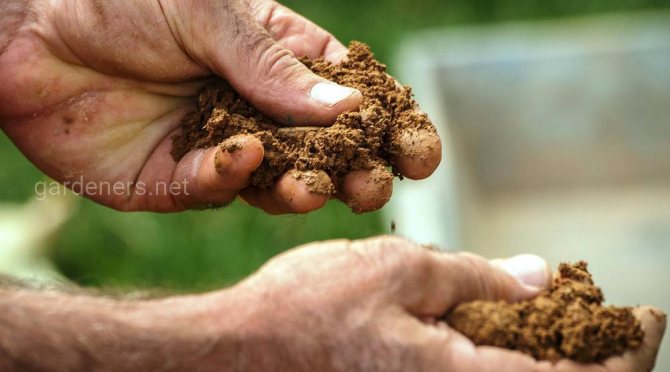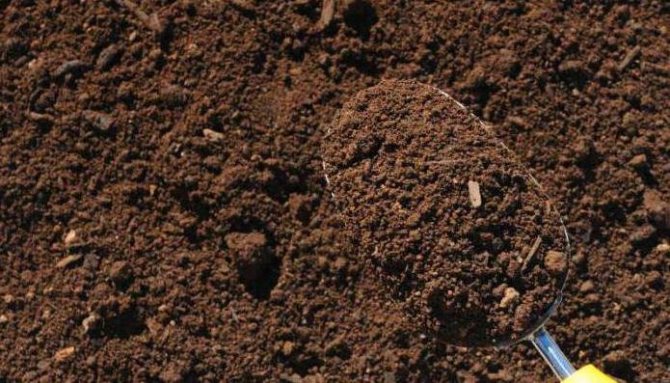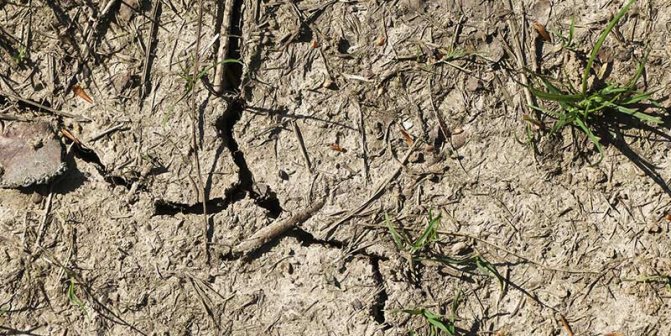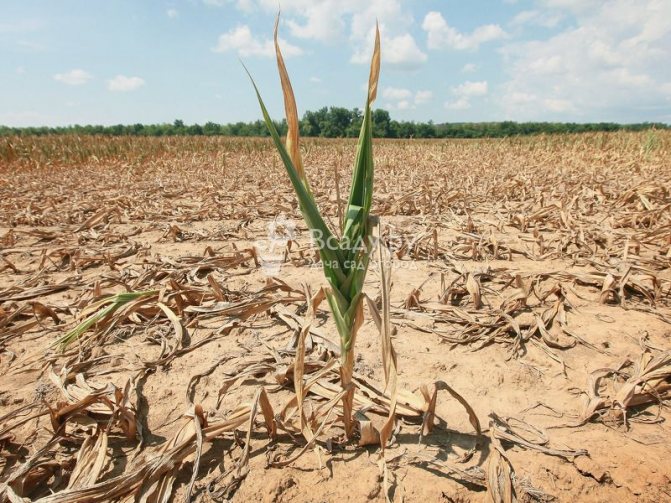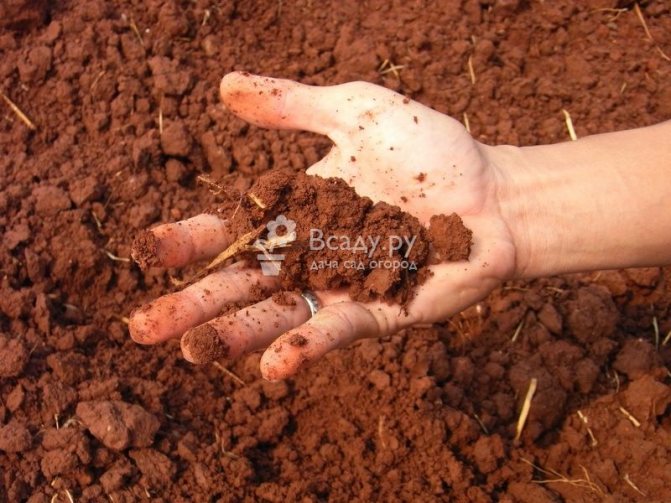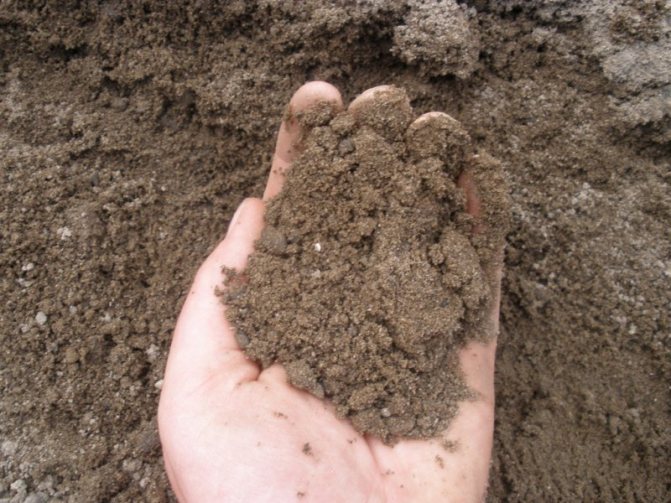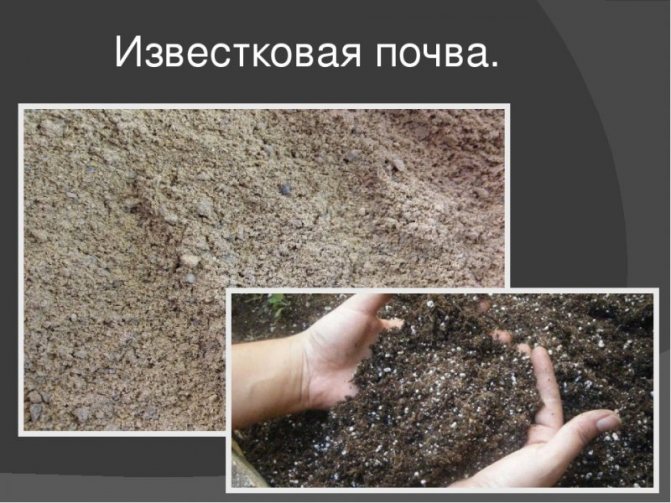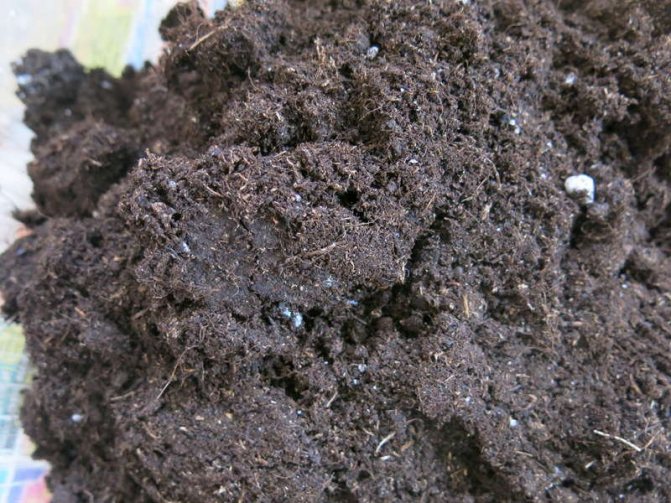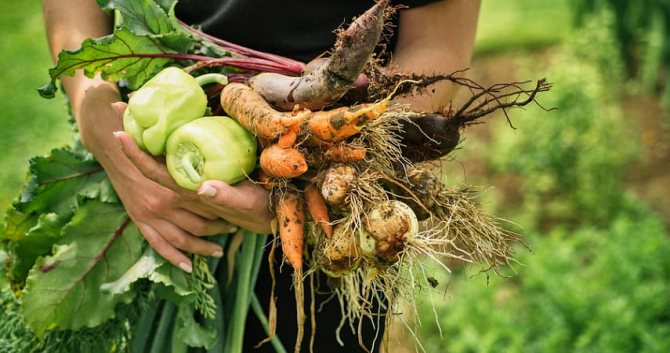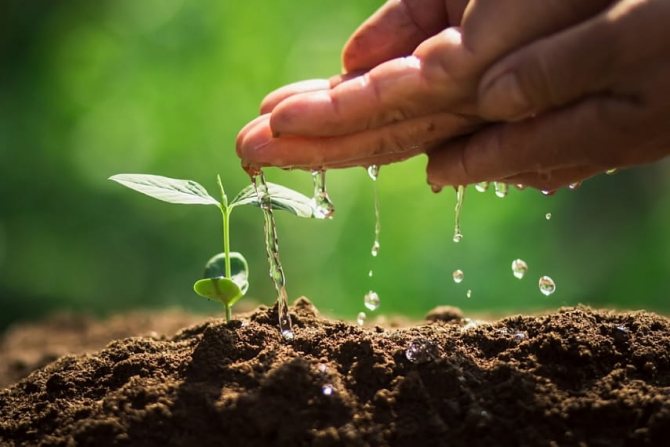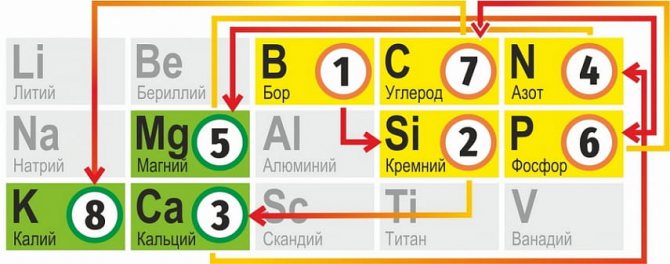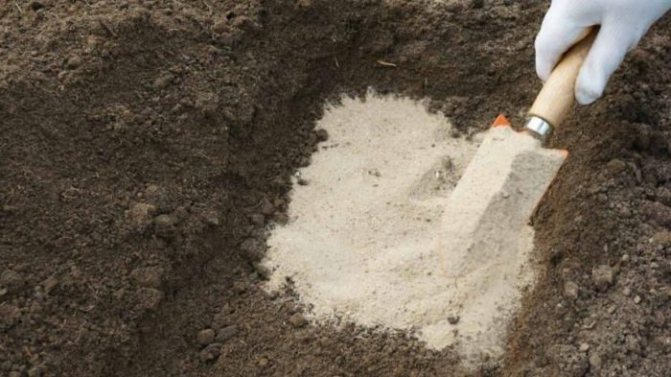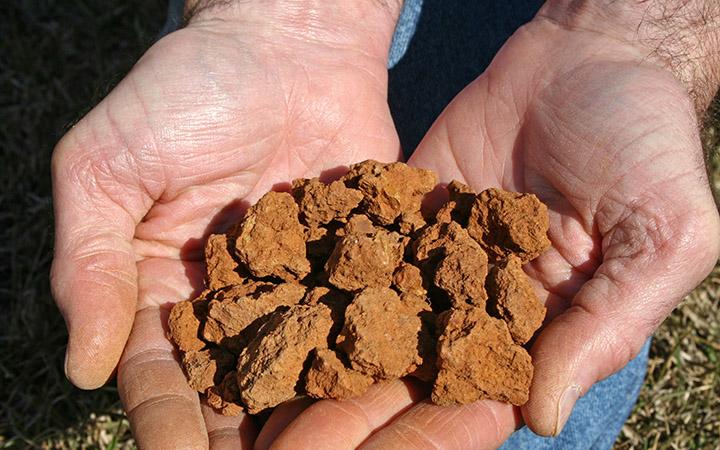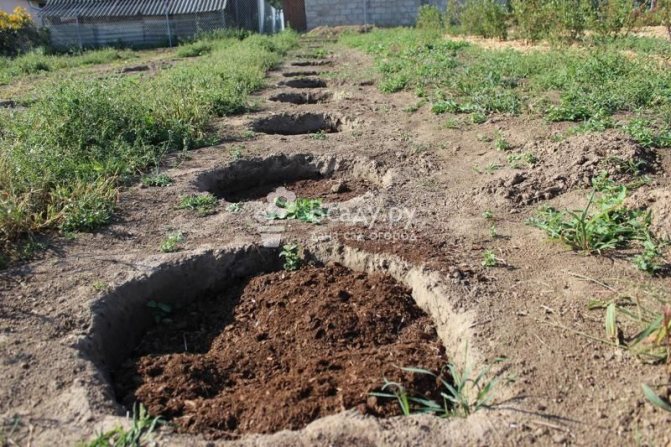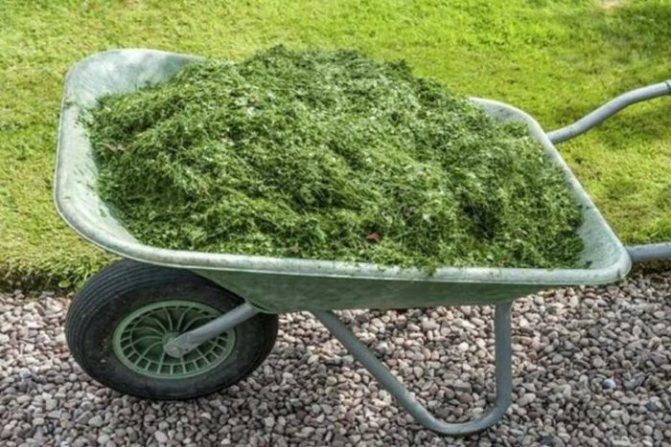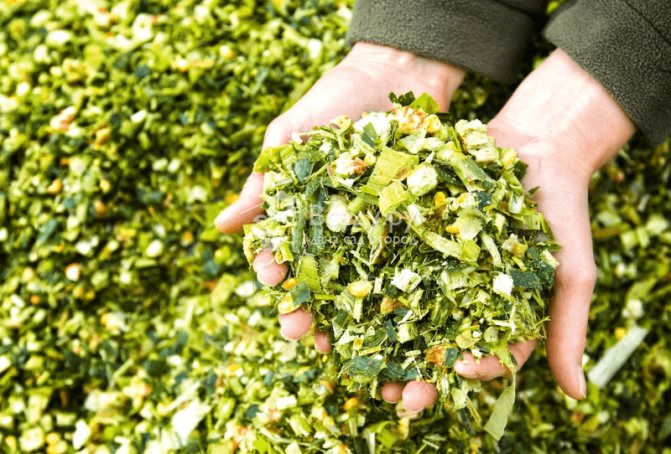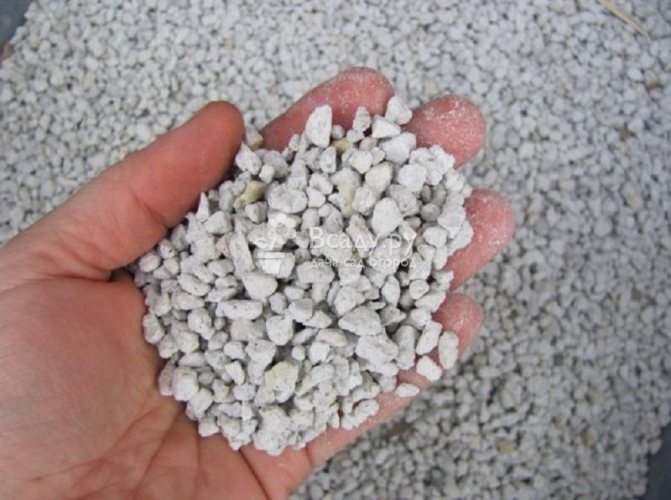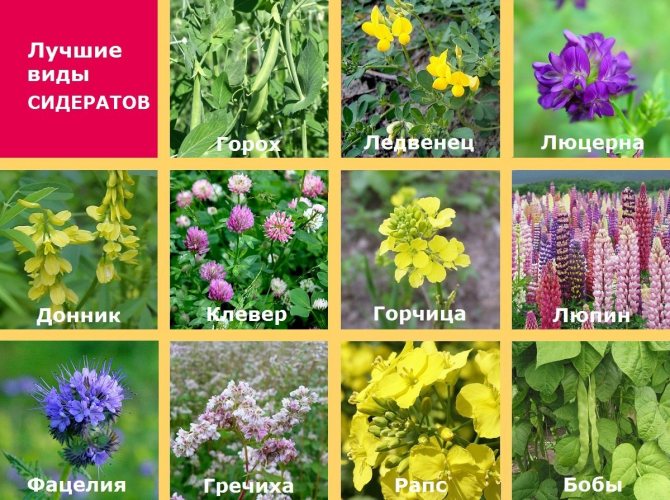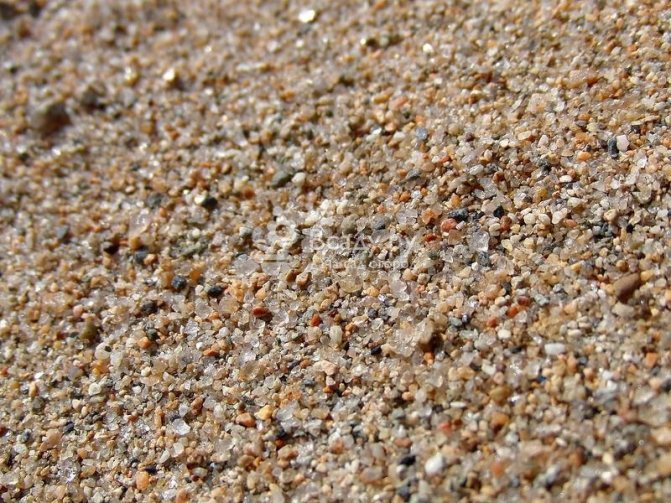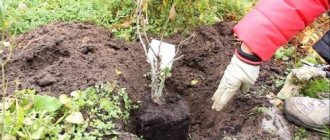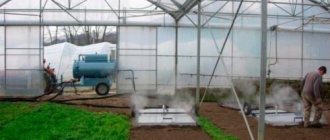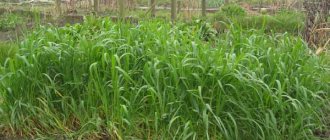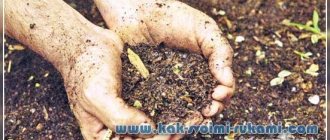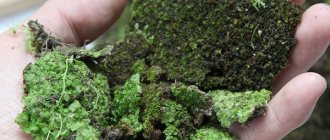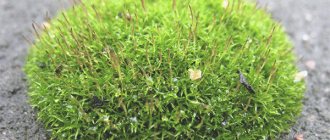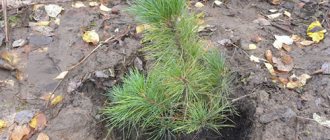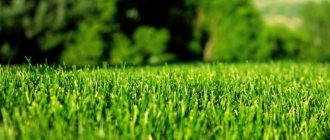Features of clay soil
Clay soils are called soils that are 80 percent or more of clay and a maximum of 20% of sand. If you try to knead a lump of such soil in your hands, it does not crumble into grains, but is smeared, painting your hands a red color, molded. Clay is rich in various mineral compounds necessary for plant growth, but they practically do not come from the dense soil to the root system, therefore, clay soil is called greedy. She also has a number of other disadvantages:
- the soil is difficult to cultivate, in dry weather it is hard, like a stone, and in a wet state it sticks to the shovel in a weighty layer;
- due to the dense structure, air circulation deteriorates;
- the soil has low thermal conductivity, heats up slowly, so the seeds take a long time to awaken;
- in the rains and after the spring melting of snow, the ground floats, there are puddles on the surface, but moisture does not penetrate deeply. Stagnant water impedes air circulation and causes acidification, and most crops do not take root on acidic soils;
- in the heat, a hard cracking crust forms on the surface.

When dry, clay soil cracks
Baking powder for seedlings
So, the soil should be light, crumbly, aerated, well-drained and structured due to correctly composed soil fractions. Baking powder is one of the main ingredients perfectly suited for this role. Let's consider baking powder separately:
Perlite
It is a baking powder made from natural material of volcanic origin ("volcanic glass"). It contains oxides of magnesium, calcium, aluminum, sodium, iron, and other elements vital for plants.
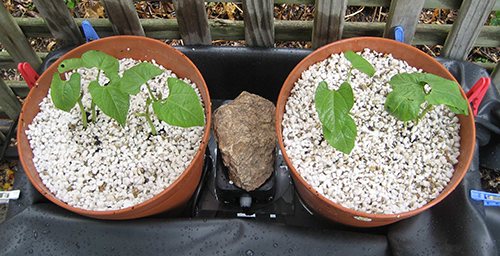

Excellent loosening agent of the soil. It surpasses vermiculite in its loosening properties. However, in some ways it is inferior to the latter. Disadvantages of Perlite:
- very expensive;
- special storage conditions are necessary so that the material does not turn into dust;
- not very absorbent;
- when working with it, be sure to use a respirator and gloves.
Vermiculite
We can say that this is the most effective baking powder, giving odds to other baking powder. It is a layered mineral formation, hydromica.
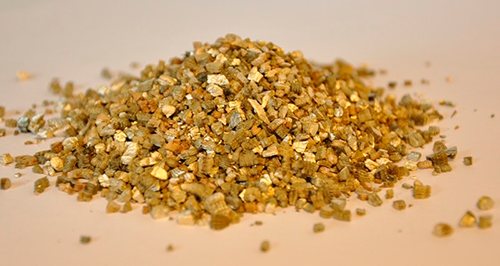

Excellent soil conditioner. Advantages over others:
- loosens caked earth;
- perfectly aerates the soil, structuring it;
- rich in minerals: iron, potassium, calcium, silicon, magnesium, etc.
- very moisture-absorbing - quickly absorbs moisture during watering, subsequently slowly releasing it to the roots, thereby making the soil moisture-absorbing;
- provides temperature balance, accumulating heat during the day and giving it back at night.
Sand
The most economical baking powder in financial terms. Only coarse river sand is used.


Sandy soil is also a source of minerals. Makes the soil porous, aerated, reduces soil caking, prevents the formation of a crust on the surface of clay soils, the earth becomes loose. Minus: not water-absorbing, not able to retain moisture in the ground.
Expanded clay


A material obtained by firing clay. Very lightweight, relatively cheap. Loosens any soil.As well as sand, it is not hygroscopic.
Peat
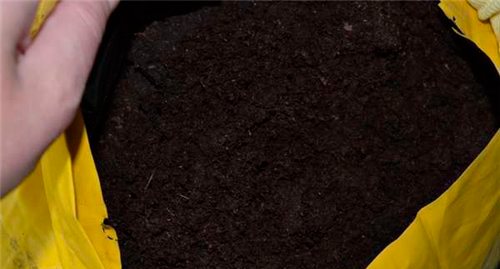

High moor peat has a light reddish, brownish tint and acidic pH. It can be used only to increase the acidity of alkalized, chalky soils. The trace element composition is very poor. Grassroots - black or very dark. It is very rich in trace elements, organic substances. It is always a part of purchased universal primers.
Helium balloons
Very beautiful, transparent, in different shades. As such, they do not carry out loosening. They are used mainly for pot crops and seedlings.
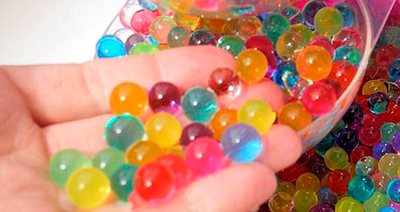

Improves the properties of the soil, revitalizing the root system of plants. They are hygroscopic: when watering, they swell, gradually releasing moisture in the future, decrease, thereby moving the soil particles, in which their loosening ability is manifested. They can grow up to 10 times their original size. They swell very slowly, so you need to saturate them with moisture in advance, at least 10 hours before use, just flooding them with water.
Christmas needles
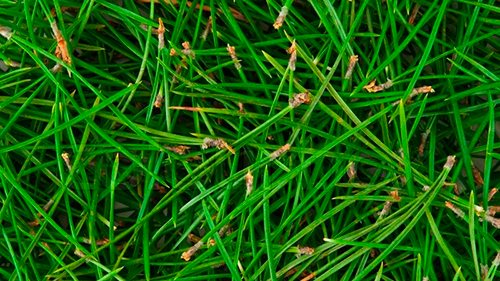

Can be typed in pine. They can be brought in only in the fall under a shovel, or when harvesting land for flowers. It should be borne in mind that they have an acidic environment (pH 4.5-5.5), thereby increasing the acidity of the soil. It can be applied only for crops that prefer this acidity (conifers, thyme, blueberries, etc.). Application together with dolomite flour and nitrogen fertilizers can perfectly loosen even slightly acidic soils. It is possible to add them only as a component not exceeding 10-20% of the loosened soil.
Pine bark
Can be bought, can be scraped off tree trunks. Apply in the fall, as ballast leavening agents.
In addition to these, there are other leavening agents. These include: coconut substrate (very moisture-absorbing, excellent soil baking powder, difficult to access), foam balls (good thermostat, washed out during watering and blown away by the wind, not quite suitable for loosening), sphagnum moss (antiseptic, very moisture-absorbing, it is expensive, excellent for loosening), coffee grounds (moisture-absorbing, can only be used for seedlings), charcoal (antiseptic, promotes loosening, can be used as drainage for soil in bowls).
Rate the article:
Rating: 4.7 / 5 - 8 votes
How to improve clay soil
The main tasks that the owners of plots with clay soil have to solve are the removal of excess water and improvement of the structure, increasing the looseness of the soil. To do this, resort to the following methods:
- drainage and leveling of the relief;
- organic additives;
- liming;
- adding river sand;
- mulching (covering the ground to regulate the water-air regime);
- sowing green fertilizers (siderates).
To combat excess moisture, it is necessary to level the relief as much as possible so that the water does not stagnate in the pits, dig a narrow trench at least 70 cm deep on the site and lay a drainage pipe on the bottom, forming a slope of 1 °. From above, the pipe is sprinkled with sand, crushed stone, earth, and its end is put into a hole dug at the lowest point of the site.
One of the ways to drain swampy clay soil is to plant barren trees closer to the house: ash, poplar, alder. Their root system draws excess moisture from the soil, but the result will only appear after a few years.
The need to determine the type, composition of soils
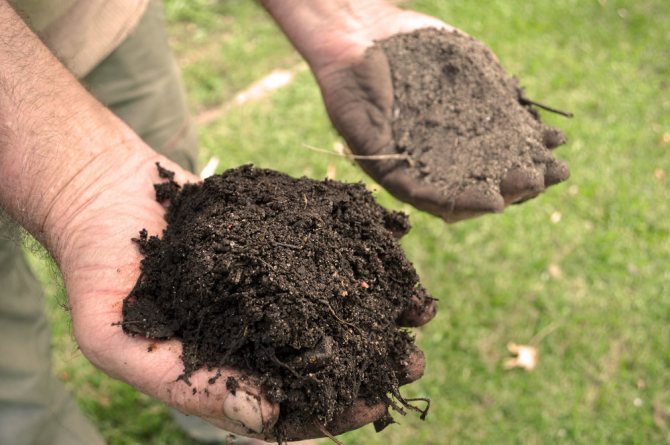

The fertility of the soil is the key to good growth, good health of plants, from which it will be possible to harvest a good harvest in the future or, in the case of decorative ones, to get lush flowering, dense greenery. Fertilizers acting as loosening agents will help to enrich the soil, make it air-permeable. To choose the right type of the latter, you need to determine the type of soil, its composition. There are two ways to solve the problem:
- Take some land to the agricultural laboratory.
- Study the mechanical composition on your own.
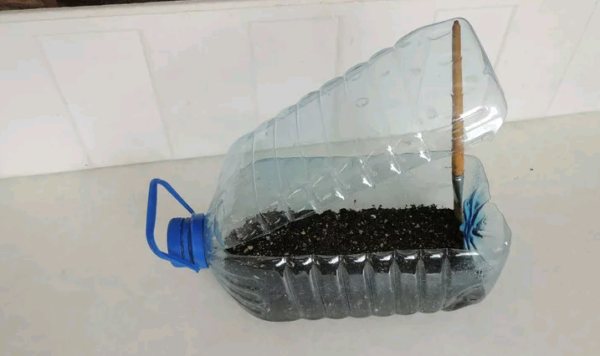

Mini greenhouse for seedlings: everything is ingenious - simple! Plastic transparent bottles of large capacity, along with the transportation and storage of water in them, are widely used in ...
The first method gives an unmistakable result, but it is not available everywhere and is expensive. The second will not answer questions about the deficiency or excess of macro- and microelements, but it will help to determine the structure of the soil. The earth is moistened with water, a ball is molded out of it. If the figure crumbles, the soil is light, if it is possible to form a kind of cord, even "twist into a ring" - heavy.
Additive technology
Clay soil does not need mineral fertilizers, it is already rich in minerals, but organic matter must be introduced. It not only increases the fertility of the soil, but also makes it lighter, friable:
- peat, tree bark, shredded branches, compost from burnt weeds, straw is laid out on top with a layer of 3-5 cm and dug up with a pitchfork, in large areas - with a plow or a ripper;
- well-rotted manure, preferably sheep or horse manure, and weathered (with a minimum iron content) peat, peat-manure, peat-faecal composts are applied when digging to a depth of 10-12 cm. fertilization until the soil structure improves;
- add old sawdust in a bucket per square meter. So that the sawdust does not extract nitrogen from the soil, they must first be enriched with urea. Sawdust, which was used as bedding for livestock, is best suited for these purposes. You can also prepare a solution of urea (150 g per 10 liters of water) - this portion is enough to soak 3 buckets of sawdust. To increase the effect, it is good to add biopreparations "Glyocladin", "Sternifag" to this solution;
- when plowing the land, it is good to mix organic fertilizers with sand, crushed and sifted through a large sieve with bricks, ash from the roots of weeds, burnt together with the earth. The most common mixture is a bucket of river sand and compost or manure per square meter, usually applied in the fall.
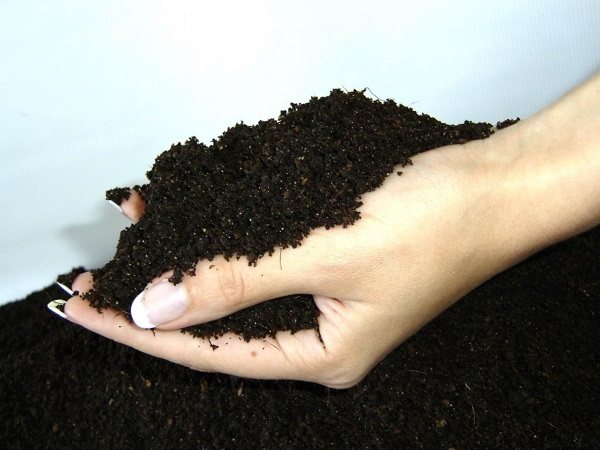

Vermicompost can turn clay soil into black soil, if applied per centner per hundred square meters per season
You can also enrich clay soil with chernozem, forming the upper fertile layer. Vermicompost additives and earthworms are very effective. Compost, humus are applied annually, the volumes can be reduced over time, but you still have to repeat the procedure, since the plants extract nutrients from the ground. During the first 5 years, sand should also be applied at least after a year, since over time it sinks down.
You can deoxidize the soil with dolomite flour, lime, chalk, but they are rich in calcium, and its excess is harmful to plants. So, you first need to conduct a laboratory analysis for the calcium content in the soil. Liming is performed only in autumn, once every 5–6 years.
For mulching, you can use sawdust, leaves, straw, chopped bark. They cover the ground in the aisles, preventing it from drying out and crusting. In addition, mulch inhibits the growth of weeds. In the fall, the beds are dug up together with mulch.
Purchased Organic Mineral Blends for Soil Improvement
Today, in gardening stores, you can find ready-made organic-mineral mixtures that are designed to make flower beds and flower beds in personal plots. Such soil can also be used to improve the indicators of the structure of the earth and increase the fruiting of the site.
The main raw material in such a mixture is peat,
to which sawdust, tree bark, fermented feces, as well as various mineral fertilizers, including potassium salts and nitrogen, are added.
The only drawback of such organic-mineral mixtures is their high cost,
therefore, gardeners usually use them pointwise to improve soil structure in greenhouses and greenhouses.
FERTILIZERS FOR THE GARDEN AND GARDEN!
• Nitrogen fertilizer • Azofosk fertilizer • Ammofosk • Nitrofosk fertilizer
It is on the physical properties and chemical composition of the soil on the site that the yield indicators of the grown vegetables, berries and fruits will depend.
A gardener, if necessary, can improve the land on the site, for which lime, peat or humus, a large amount of other organic matter, mineral fertilizers are added to it, or fast-growing green manure crops are planted. Carrying out such a simple work to improve the composition of the soil will significantly increase the yield, and the gardener will see the first results literally a year after fertilizing and domesticating the soil.
Features of cultivation of clay soil
The basic principles that must be adhered to when conducting garden work on alumina:
- do not dig the ground to a depth of more than 25 cm, fertilize only the top 10-15 cm;
- do not leave empty areas, after harvesting garden crops, sow green manure (soil-forming plants): lupine, vetch, phacelia, mustard. After flowering, the plants are mown and leave the green mass in the beds until late autumn;
- before the start of the autumn rains, the site is dug up for the winter along with mulch, green mass, without breaking lumps. During the winter, the structure of the earth in lumps will improve, after which it can be dug up again. If winter rye was sown at the end of August, the land is plowed only in the spring, immediately before planting garden crops;
- it is good to dig a ditch (compost pit) and unload food waste, plant tops into it all summer, and bury it in the fall. It is also recommended to lay the weeded grass, tops on the paths, in the fall to add them to the furrows;
- add a little compost, rotted sawdust or black soil to the bottom of the holes, grooves, immediately before planting seedlings, sowing seeds;
- reduce the depth of sowing seeds, burying potato tubers, and plant seedlings slightly obliquely so that the roots are located in the upper layers.
If you do not have enough strength and finances to dig up the entire area with the addition of sand and organic matter, you can form several ridges 50-60 cm wide with meter-long row spacing. The ridges are not dug up, but loosened to a depth of 20 cm, adding sand and compost. Grooves are formed for seedlings, and the aisles are mulched. Mulch is also left for the winter, adding top dressing for it - organic waste, compost. Such a garden does not need watering, there is enough moisture in the clay soil, and the mulch does not allow it to evaporate.
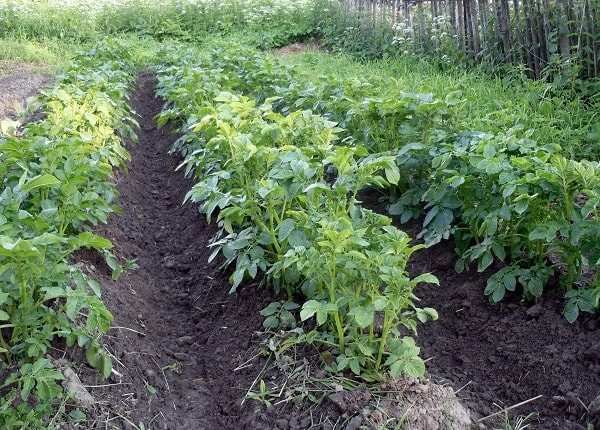

The bed method allows you to reduce labor costs, time and save on feeding
Plants for soil improvement - the use of green manure
Sideration of the soil is an extremely simple and effective way to improve soil fertility indicators,
at the same time, the gardener receives a noticeable result the next year after carrying out such an agrotechnical procedure.
The crop grown on the site is environmentally friendly and has a great taste. Greening means planting a catch crop after the main harvest, which is subsequently embedded in the soil, rotted, enriching it with various nutrients.
Siderata plants - photo
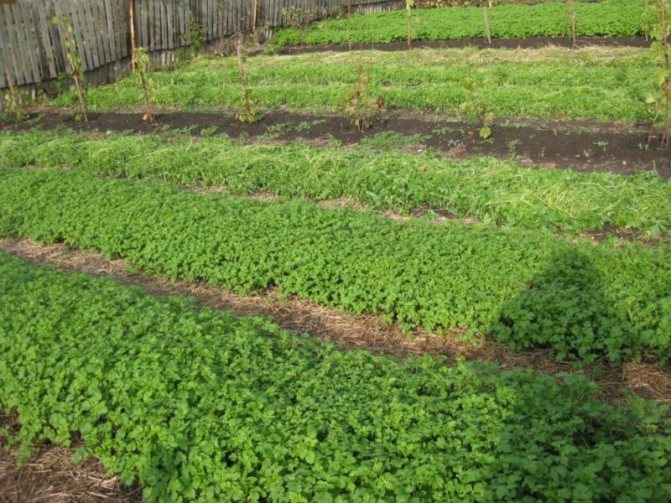

The following crops are used to improve the soil: mustard, beans, peas, lupine, alfalfa, and so on. They are planted at the end of July - in August, the plants, under suitable conditions, grow the green mass literally for two months, after which they are mowed and embedded in the soil to a depth of 20-30 centimeters.
Additionally, it is recommended to enrich the land with phosphorus and potash fertilizers, which are vital for plants for the development and active fruiting.
What can be planted on clay soil
Alumina is better suited for horticultural crops, trees, roses and strawberries love such soil. But root crops and bulbous plants do not do well in heavy, dense soil. On alumina with moderate sand additives (half a bucket per square meter) grow well:
- from flowers, ornamental plants - peonies, daylilies, aquilegia, delphinium, gladioli, rudbeckia (in the sun), Volzhanka, black cohosh, hosta, tenacious (in the shade);
- from fruit trees - apple, plum, cherry, quince;
- from shrubs - irga, raspberry, hawthorn;
- vegetable crops - cabbage, beets.
For other vegetables and annual flowers, the soil should be looser, lighter, for each square of the area you need a bucket of sand. Under the grapes, mix well the alumina with crushed brick, turf soil.
It will not be possible to transform the clay soil in one step, but as a result of systematic dressings and sand additions, in about 5 years it can turn into loam, which is quite fertile and lighter.
Fertile soil in the garden
A small fertile layer of land is found on the surface of the earth. Soil fertility depends on the content of organic matter in it. The soil should be periodically given rest, not to plant anything during the year. But continue to weed, fertilize, mulch. In autumn - dig up so that the top layer goes down.
In order for the soil to become loose, it is necessary to plant annual plants on it for several years in a row, which loosen the soil with their roots. In addition, the remnants of the root system and the left upper part of the plants, microorganisms living in the ground, form a useful organic layer. Seedlings of plants need to be covered with mulch (foliage, straw, needles) by 15 centimeters, this will retain moisture and keep it from the sun's rays.
During growth, plants not only consume micronutrients, but also produce them. Therefore, if you plant different types of plants on the same bed, they will enrich and feed each other. As a result, the incidence of diseases decreases, the soil and the condition of plants are improved.
We fertilize in the spring
Cow dung is not recommended to be used in its pure form, it contains few nutrients, but there are remnants of weed roots, harmful microorganisms.
It is best used for cooking humus. And fresh manure must be applied to the ground in the fall. Improved fertilized soil will already be prepared by spring. Horse manure is more nutritious than cow manure. There are no weed roots, pest eggs, pathogenic bacteria in it. The heat it generates as it decomposes allows it to be used to prepare warm soil for the beds.
It is good to prepare mulch from rotted horse manure. It is mixed with other types of manure and added to compost. If you mix rotted manure with peat, you get a good organic fertilizer for improving the soil in your garden. It can be put in the ground when digging, added to the holes when planting plants.
You can enhance the effect of organic fertilizers by adding mineral fertilizers to them - nitrogen, phosphorus.
For humus, fresh manure is placed in a special container, alternating with peat and adding lime or phosphorus flour. The layers should be 20–25 cm thick. The mixture should be moistened periodically.
You need to compost for six months - a year. Manure should not be left uncovered for storage. Beneficial properties will be lost. It must be covered with peat or earth.
Mulch
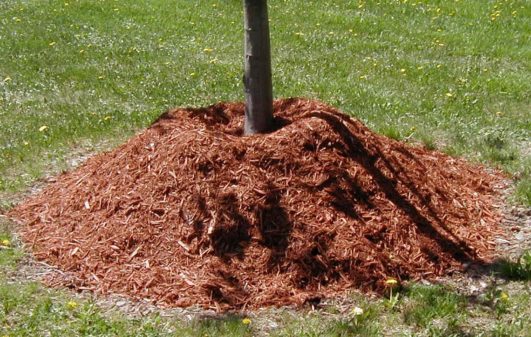

Photo: Mulch for soil improvement
Mulch is laid out on the soil in the fall, In this case, the soil does not freeze longer. In the spring, mulch is harvested to thaw and warm up the earth.
When planting potatoes, the tubers are laid out on the soil and covered with a layer of mulch. When sprouts appear, you need to spread another layer on top. The tubers appear intact. Pests in mulch do not multiply.

